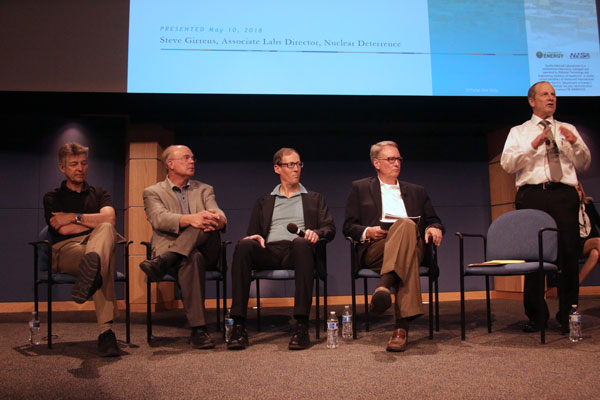
(Left to right): Directors Mark Rosenthal, Cliff Renschler, Scott Holswade (with mic) and Rick Fellerhoff, and Associate Labs Director Steve Girrens (Berlinda Eras is partially visible behind Girrens on the far right).
“I’ve been a Sandian for 375 days, and it’s been the most exciting 375 days of my life. Thank you all for allowing me to be here and work with you,” Chief Engineer and Nuclear Deterrence Associate Labs Director Steve Girrens told a May 10 all hands audience.
This meeting was the second Nuclear Deterrence (ND) portfolio-wide all hands meeting since the change of Sandia’s management and operating contract last year. Steve used the opportunity to share his excitement about being a Sandian with audiences in New Mexico and those watching from California, the Weapons Test Laboratory at Pantex in Texas, and Washington, D.C.
Steve acknowledged the incredible job everyone is doing Labs-wide to successfully deliver on the record amount of mission work, with indications that the next few years will be even busier than initially predicted.
Record-setting mission work
“Budgets are still increasing,” said Rick Fellerhoff, of the ND Program Management Office and deputy Associate Labs Director, who outlined projects for FY19 and beyond that illustrate the Labs’ continued project growth. “We used to project that budgets would be tailing off in FY20 and beyond, but now it looks like we’re going to be big well into next decade.”
Rick noted that the $200 million increase in mission work from FY17 to FY18 “is about the biggest annual increase we can absorb.” He said increases of that magnitude are especially challenging when the Labs must operate under a continuing resolution, as it did earlier this year and last year. Rick credits extensive Labs leadership planning and coordination with NNSA for continued hiring of the talent needed while budgets worked their way toward congressional approval.
Such a high volume of work would not be possible, Rick says, without significant recapitalization investments made over a decade ago in Microsystems and Engineering Sciences Applications, Z Machine and Area III environmental testing improvements, which helped prepare Sandia infrastructure and capabilities for the current volume of mission work.
Rick sees the same type of recapitalization investment required as Sandia continues to deliver on its major commitments into the future. “If we’re going to be taxing our infrastructure as we are now, with all this great work, we need to ensure continuing infrastructure renewal and refurbishment to keep us prepared for future work,” Rick said.
What does the future hold?
Steve touched on potential 2018 Nuclear Posture Review impacts for Sandia and emphasized that nothing is “reality” until there is an implementation plan and funding, but said, “We’re ready to go on potential work fronts when and if that happens.”
Director Joel Lash of Engineering Sciences presented on the challenge of Sandia developing a full engineering model of stockpile systems, outlining how new approaches to modeling will help cover the spectrum of environments, disciplines, fidelity and applications. Joel said four initial proposals are slated to start next year, including one that is a Laboratory Directed Research and Development Mission Campaign.
The 90-minute meeting also featured discussions of accomplishments by directors Scott Holswade, Jim Handrock, Cliff Renschler and Mark Rosenthal, and Ming Lau, senior manager for the California program.
Each director laid out his responsibilities and the structure for parts of the ND portfolio, and shared important technical milestones on projects that support Labs’ production and its six major programs — B61-12 Life Extension Program (LEP), W76-1 LEP, W87/Mk21 Fuze Replacement, W80-4 LEP, W88-0/Mk5 Alteration and the Mobile Guardian Transporter.
Challenges
“All of those Labs’ accomplishments don’t happen without people,” Steve said. He explained that 60 percent of Sandia employees have been here less than 10 years and 80 percent, less than 20 years. He views this movement as “a healthy indicator that we’re vibrant moving into the future.”
Steve emphasized that it’s important to the nation that Sandia remain one of the best places in the country to work. “If it’s not, we’re not going to maintain that hiring and bring in all those people who get the work done.”
“You’re the premiere workforce for executing this important mission for the United States of America in national security.”
Despite Sandia’s success in hiring, the challenge is ongoing. “We can’t lighten up on our hiring focus — keep the pedal down,” Steve said
Steve ended with a thank you and a reminder, “You’re the premiere workforce for executing this important mission for the United States of America in national security.” He encouraged all to keep up the good work.
Members of the workforce who missed it can watch and listen to the meeting online.